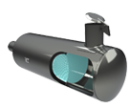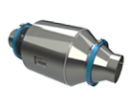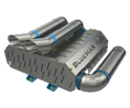Check our M-Series (Metallic) and D-Series (Ceramic) catalytic converters designed especially for diesel engines…
How Are Diesel Emissions Regulated?
All diesel engines for highway applications and some for off-road use are subject to the "tailpipe" emission regulations. These regulations specify the maximum amount of pollutants allowed in exhaust gasses from a diesel engine. The emissions are measured over an engine test cycle which is also specified in the regulations. The duty to comply is on the equipment (engine) manufacturer. All equipment have to be emission certified before they can be released to the market. The authorities regulating engine tailpipe emissions include the US EPA (Environmental Protection Agency) and California ARB (Air Resources Board). An example of this class of regulations is the EPA requirement that diesel particulate matter emissions from all heavy-duty diesel engines for highway use are below 0.1 g/bhp-hr.
Many applications of diesel engines in confined spaces are regulated through ambient air quality standards rather than by tailpipe regulations. The ambient air quality standards specify the maximum concentrations of air contaminants which are allowed in the workplace. These regulations are set and enforced by occupational health and safety authorities such as OSHA (Occupational Health and Safety Administration) or MSHA (Mining Safety and Health Administration). The duty to comply is on the end-user (mine operator, warehouse operator, etc.) who has to make sure that the emission control measures which have been employed are adequate to the type and number of polluting equipment. A trade-off between several emission control methods is always possible. For example, the use of exhaust aftertreatment devices allows for a lower ventilation rate in the building. The final choice of emission control strategy can be, thus, dictated by economics.
The exact Threshold Level Values (TLV) of particular air contaminants vary between different jurisdictions. Typical TLV values for diesel exhaust pollutants, based on the ACGIH (American Conference of Governmental Industrial Hygienists) guidelines for 1993-1994, are listed in Table 2.
| Substance | TWA1) | STEL2) | ||
|---|---|---|---|---|
| ppm | mg/m3 | ppm | mg/m3 | |
| Carbon Monoxide | 25 | 29 | - | - |
| Nitric Oxide | 25 | 31 | - | - |
| Nitrogen Dioxide | 3 | 5.6 | 5 | 9.4 |
| Formaldehyde3) | 0.34) | 0.374) | - | - |
| Sulfur Dioxide | 2 | 5.2 | 5 | 13 |
| Sulfuric Acid | - | 1 | - | 3 |
| Diesel Particulates | - | 0.155) | - | - |
| 1) Time-Weighted Average for a normal 8-hour workday. 2) Short-Term Exposure Limit, defined as a 15-minute TWA. 3) Suspected human carcinogen (A2). 4) Ceiling TLV. 5) ACGIH Notice of Intended Changes for 1995-1996, suspected human carcinogen (A2). | ||||
Nett Technologies’ Diesel Oxidation Catalysts (DOC)

Nett Technologies’ Diesel Particulate Filters (DPF)
Manufactured using either Cordierite or Silicon Carbide substrates, DPFs are an effective solution to Diesel…

Nett Technologies’ Selective Catalytic Reduction (SCR) Systems
Designed to control the emissions of Nitrogen Oxides (NOx) from medium to heavy duty diesel…

Request A Quote
Photo Gallery

